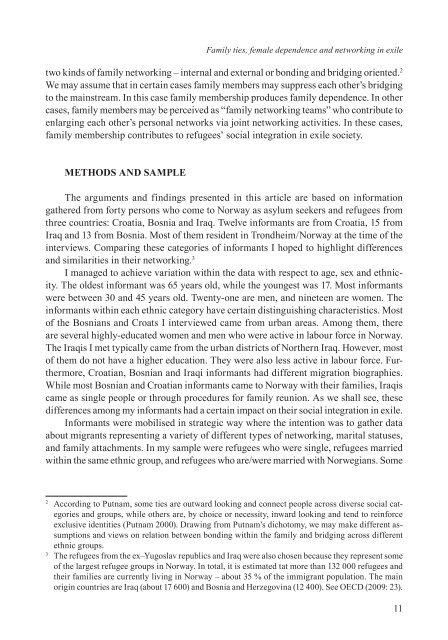30 • 2009 - Dve domovini / Two Homelands - ZRC SAZU
30 • 2009 - Dve domovini / Two Homelands - ZRC SAZU
30 • 2009 - Dve domovini / Two Homelands - ZRC SAZU
Create successful ePaper yourself
Turn your PDF publications into a flip-book with our unique Google optimized e-Paper software.
Family ties, female dependence and networking in exile<br />
two kinds of family networking – internal and external or bonding and bridging oriented. 2<br />
We may assume that in certain cases family members may suppress each other’s bridging<br />
to the mainstream. In this case family membership produces family dependence. In other<br />
cases, family members may be perceived as “family networking teams” who contribute to<br />
enlarging each other’s personal networks via joint networking activities. In these cases,<br />
family membership contributes to refugees’ social integration in exile society.<br />
METHODS AND SAMPLE<br />
The arguments and findings presented in this article are based on information<br />
gathered from forty persons who come to Norway as asylum seekers and refugees from<br />
three countries: Croatia, Bosnia and Iraq. Twelve informants are from Croatia, 15 from<br />
Iraq and 13 from Bosnia. Most of them resident in Trondheim/Norway at the time of the<br />
interviews. Comparing these categories of informants I hoped to highlight differences<br />
and similarities in their networking. 3<br />
I managed to achieve variation within the data with respect to age, sex and ethnicity.<br />
The oldest informant was 65 years old, while the youngest was 17. Most informants<br />
were between <strong>30</strong> and 45 years old. Twenty-one are men, and nineteen are women. The<br />
informants within each ethnic category have certain distinguishing characteristics. Most<br />
of the Bosnians and Croats I interviewed came from urban areas. Among them, there<br />
are several highly-educated women and men who were active in labour force in Norway.<br />
The Iraqis I met typically came from the urban districts of Northern Iraq. However, most<br />
of them do not have a higher education. They were also less active in labour force. Furthermore,<br />
Croatian, Bosnian and Iraqi informants had different migration biographies.<br />
While most Bosnian and Croatian informants came to Norway with their families, Iraqis<br />
came as single people or through procedures for family reunion. As we shall see, these<br />
differences among my informants had a certain impact on their social integration in exile.<br />
Informants were mobilised in strategic way where the intention was to gather data<br />
about migrants representing a variety of different types of networking, marital statuses,<br />
and family attachments. In my sample were refugees who were single, refugees married<br />
within the same ethnic group, and refugees who are/were married with Norwegians. Some<br />
2<br />
According to Putnam, some ties are outward looking and connect people across diverse social categories<br />
and groups, while others are, by choice or necessity, inward looking and tend to reinforce<br />
exclusive identities (Putnam 2000). Drawing from Putnam’s dichotomy, we may make different assumptions<br />
and views on relation between bonding within the family and bridging across different<br />
ethnic groups.<br />
3<br />
The refugees from the ex–Yugoslav republics and Iraq were also chosen because they represent some<br />
of the largest refugee groups in Norway. In total, it is estimated tat more than 132 000 refugees and<br />
their families are currently living in Norway – about 35 % of the immigrant population. The main<br />
origin countries are Iraq (about 17 600) and Bosnia and Herzegovina (12 400). See OECD (<strong>2009</strong>: 23).<br />
11

















